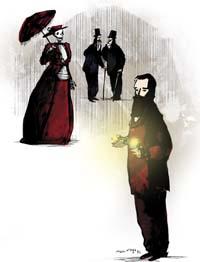Ray of Röntgen

On 23 January 1896, at the University of Würzburg, crowds gathered to witness that scientific exhibition. The room was hanging, with chairs full of amphitheater and people standing next to the walls. A young man approached the table and the audience suddenly shut up. Then came a bearded man of little height and the public rose with respect to that scientist. He reached the table taking great steps and the young man said: "Ladies and gentlemen, Professor Wilhelm Röntgen demands his attention with total respect."
Röntgen began to explain his latest discovery with well-measured words. He did not lengthen much, and finally asked the prestigious anatomist Albert von Kölliker for permission to take a "photo" out of his hand. Kölliker accepted it eagerly. Röntgen showed the photo in a few minutes. The answer was applause. It clearly showed the bones of the hand, one of the first x-rays.
The first took him to his wife a month earlier. It all began in November 1895. Röntgen was already 50 years old and was known among scientists, both as a respected university professor, as a researcher who worked rigorously and accurately. At that time, like other physicists, he researched the properties of cathodic rays. He repeated the works of Hertz, Lenard, Hittorf and Crookes and ratified the results obtained by them. But he also made other contributions. He observed, for example, that cathodic rays darkened photographic plates and that some salts produced fluorescence, especially in barium platocyanide.
On November 8, 1895 he realized a very curious thing: although cardboard was placed between the cathodic ray tube and the platocyanide-coated plates, fluorescence appeared on the plate. How could it be? How did the rays reach the plate? In fact, cardboard had to logically hinder the cathode rays. But then what caused this fluorescence?
It was Friday afternoon and I was alone in the laboratory. To ensure what was going on, he covered the whole tube with black cardboard and placed the room in the dark so that sunlight had nothing to do with it. The cardboard did not allow the cathodic rays to pass, but when the cyanide-coated plate approached, the fluorescent light appeared. He was surprised at Röntgen. There was something they did not know; something, perhaps invisible rays, went through the cardboard and reached the plate.
He spent the whole weekend in the lab, doing repeated tests, trying to understand what was going on. So he said to his wife Anna: "When people learn what I'm doing, 'Röntgen has lost his head!' will say."
But Röntgen knew that what he was seeing was real and that he was not crazy. However, for a while he said nothing to anyone. For several weeks his wife and both experienced. Having no idea what that radiation was capable of going through the cardboard, he called them x-rays. And they saw that, besides the cardboard, they crossed the wood and also the wall. The only thing that stopped these rays were metals. For example, when metal weights were placed in front of a photographic plate, the silhouettes of those weights appeared clear on the plate.
What happened on December 22 was what surprised the most. Anna placed her hand on a photographic plate and subjected it to X-rays for 15 minutes. He left the results breathless. It was no less; to see in the photo the skeleton of the hand (and the ring) provoked at the same time fascination and panic. This is demonstrated by the first words that Anna could pronounce: "I have seen my death!"
On 28 December, the article by Über eine neue Art von Strahl published everything Röntgen had learned about these new rays. The news spread immediately. On January 5, London Daily Chronicle said: "The rumor of a war alarm should not distract our attention from the fascinating achievement of science communicated in Vienna. As announced, Dr. Röntgen of the University of Würzburg has found a light when photographing, which traverses meats, clothes and other organic substances."
Applications were also seen immediately, especially doctors. Being able to see the interior without opening the body was awesome. The anatomist Kölliker also saw the importance of discovery in the Würzburg exhibition. He recognized it right there, seeing the skeleton of his hand. And he proposed to call those Röntgen rays.
But Röntgen himself preferred to keep calling x-rays. He was a humble man. He refused to patent the discovery even when he was offered the title Von. However, he received several honors. The Nobel prizes were awarded for the first time in 1901, and the physics prize went to Röntgen. He donated the prize money to the University of Würzburg.





